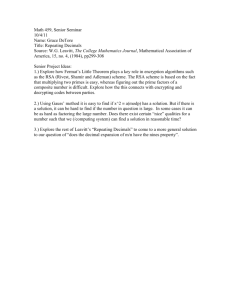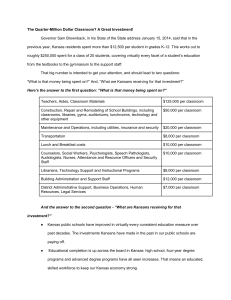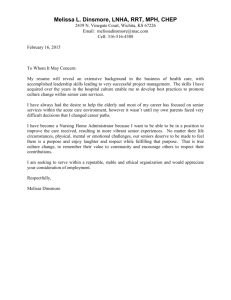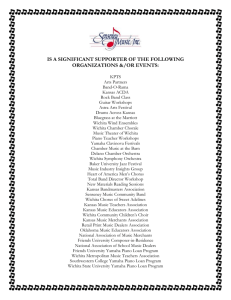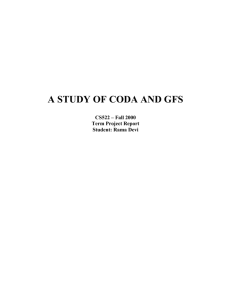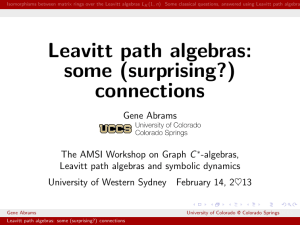FESTIVAL-SANCTUS
advertisement
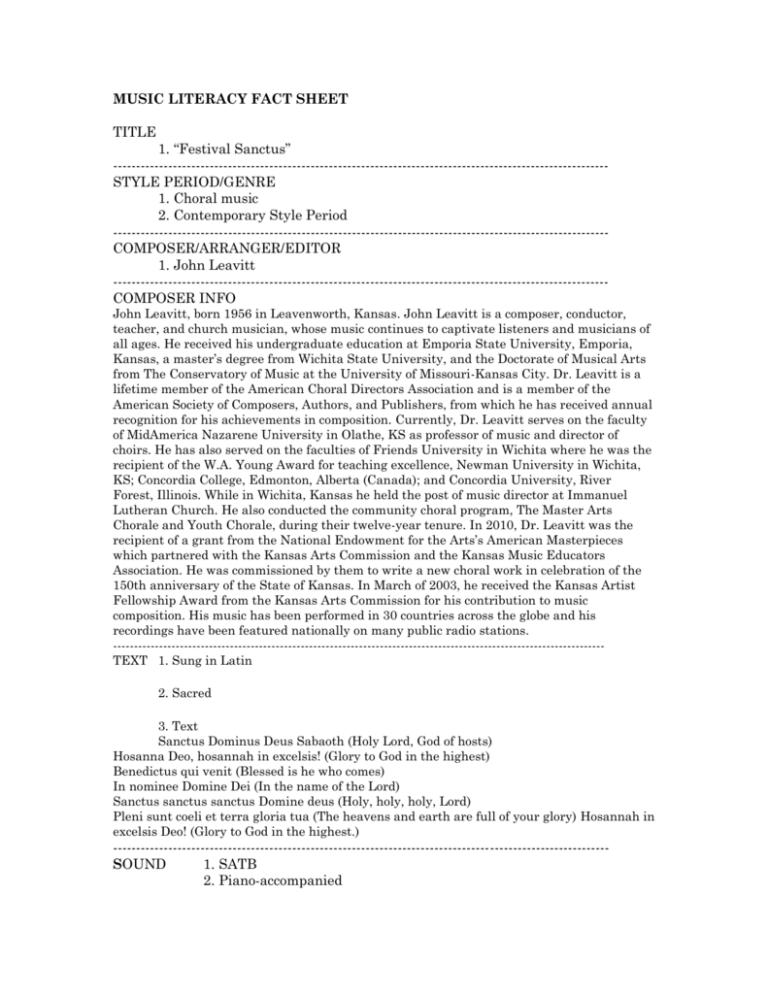
MUSIC LITERACY FACT SHEET TITLE 1. “Festival Sanctus” -----------------------------------------------------------------------------------------------------------STYLE PERIOD/GENRE 1. Choral music 2. Contemporary Style Period -----------------------------------------------------------------------------------------------------------COMPOSER/ARRANGER/EDITOR 1. John Leavitt -----------------------------------------------------------------------------------------------------------COMPOSER INFO John Leavitt, born 1956 in Leavenworth, Kansas. John Leavitt is a composer, conductor, teacher, and church musician, whose music continues to captivate listeners and musicians of all ages. He received his undergraduate education at Emporia State University, Emporia, Kansas, a master’s degree from Wichita State University, and the Doctorate of Musical Arts from The Conservatory of Music at the University of Missouri-Kansas City. Dr. Leavitt is a lifetime member of the American Choral Directors Association and is a member of the American Society of Composers, Authors, and Publishers, from which he has received annual recognition for his achievements in composition. Currently, Dr. Leavitt serves on the faculty of MidAmerica Nazarene University in Olathe, KS as professor of music and director of choirs. He has also served on the faculties of Friends University in Wichita where he was the recipient of the W.A. Young Award for teaching excellence, Newman University in Wichita, KS; Concordia College, Edmonton, Alberta (Canada); and Concordia University, River Forest, Illinois. While in Wichita, Kansas he held the post of music director at Immanuel Lutheran Church. He also conducted the community choral program, The Master Arts Chorale and Youth Chorale, during their twelve-year tenure. In 2010, Dr. Leavitt was the recipient of a grant from the National Endowment for the Arts’s American Masterpieces which partnered with the Kansas Arts Commission and the Kansas Music Educators Association. He was commissioned by them to write a new choral work in celebration of the 150th anniversary of the State of Kansas. In March of 2003, he received the Kansas Artist Fellowship Award from the Kansas Arts Commission for his contribution to music composition. His music has been performed in 30 countries across the globe and his recordings have been featured nationally on many public radio stations. ---------------------------------------------------------------------------------------------------------------------TEXT 1. Sung in Latin 2. Sacred 3. Text Sanctus Dominus Deus Sabaoth (Holy Lord, God of hosts) Hosanna Deo, hosannah in excelsis! (Glory to God in the highest) Benedictus qui venit (Blessed is he who comes) In nominee Domine Dei (In the name of the Lord) Sanctus sanctus sanctus Domine deus (Holy, holy, holy, Lord) Pleni sunt coeli et terra gloria tua (The heavens and earth are full of your glory) Hosannah in excelsis Deo! (Glory to God in the highest.) -----------------------------------------------------------------------------------------------------------SOUND 1. SATB 2. Piano-accompanied -----------------------------------------------------------------------------------------------------------HARMONY 1. homophonic 2. Major Key -----------------------------------------------------------------------------------------------------------MELODY 1. Complex 2. sequence (a melodic pattern, or a progression of chords, that is repeated at successively higher, or lower, pitches.) -----------------------------------------------------------------------------------------------------------RHYTHM 1. complex 2. duple feel -----------------------------------------------------------------------------------------------------------GROWTH/FORM 1. intro ABA coda -----------------------------------------------------------------------------------------------------------TIME SIGNATURE 1. 4/4 & 6/8 2. Consistent Tempo 3. quarter note = ca. 120 -----------------------------------------------------------------------------------------------------------KEY SIGNATURE 1. A Major 2. 3 sharps (#) -----------------------------------------------------------------------------------------------------------NOTEWORTHY correct Latin pronunciation was an important consideration for us in this song. Examples – Sabaoth (sah-bah-awtt), Dominus (Daw-mee-noose) as the melody is repeated, there is dynamic increase to heighten the intensity and build the excitement. TERMS crescendo/decrescendo – gradually get louder, gradually get softer dynamics – p (piano – soft), mp (mezzo-piano – medium soft), mf (mezzo-forte – medium loud), f (forte – loud), ff (fortissimo – very loud) rit. (ritardando) - gradually slower, retarding, to hold back, holding back, held back (gradual change of tempo), gradually delaying the tempo triplet – a group of three notes of equal time value performed in the time of one (sometimes two) of them unis. (unison) - when an ensemble sings or plays the same notes even when these are an octave or several octaves apart, they are said to 'playing in unison' dim. (diminuendo) - diminishing, gradually getting softer, diminishing in loudness tutti – all parts sing together Coda - a closing passage generally added to the end of a composition. coda sign - or 'jump to coda sign', a circle or oval with a cross inside it which directs the player to jump from that point to a section marked Coda

